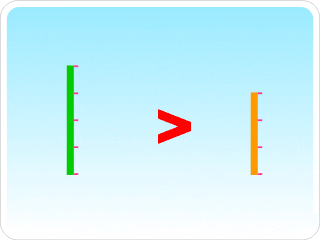-
A relationship between two expressions that are not equal, often written with the symbols >, >, <, and < that mean greater than, greater than or equal, less than, less than or equal, respectively.
For example, "4 is greater than 3" can be written as "4 > 3". Inequalities that contain only numerical values will be either true (such as 4 > 3) or false (such as 1 > 2).
Inequalities that also contain variable(s) will usually be true for some values of the variable. To solve an inequality in one variable means to find the solution set of an equivalent inequality having the form x < a, x < a, x > a, or x > a, or the intersections or unions of the sets having these forms. An inequality is solved in much the same way as an equation.
2x - 1 > 9 original inequality 2x > 10 addition property (adding 1) x > 5 division properties (dividing by 2) When adding or subtracting the same quantity from both sides of a true inequality, it will remain true. When multiplying or dividing both sides of a true inequality by the same positive quantity, it will remain true. However, you must reverse the inequality when multiplying or dividing both sides of a true inequality by the same negative quantity.
